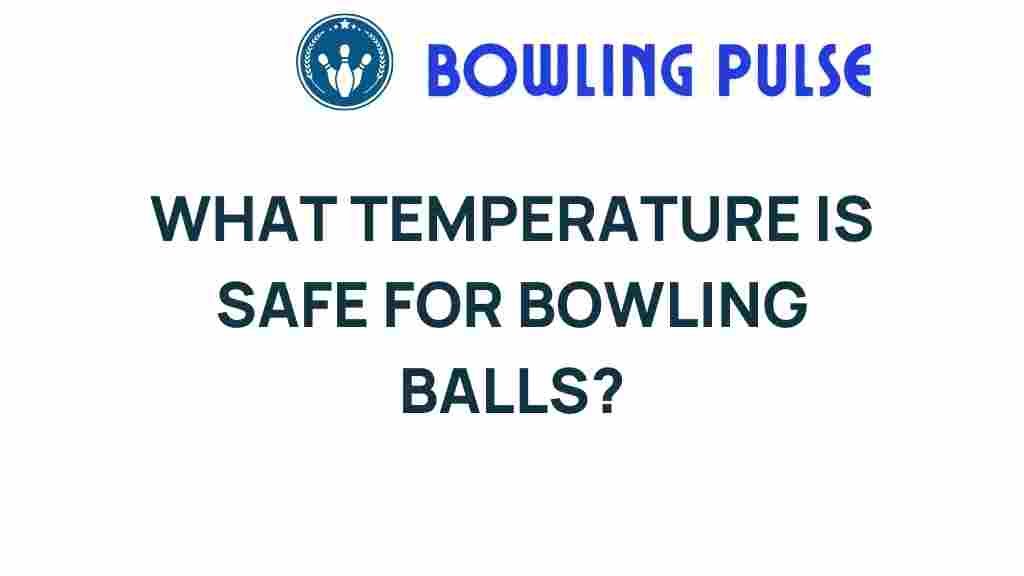What Temperature Is Safe for Bowling Balls?
When it comes to the sport of bowling, the equipment used plays a crucial role in performance. One of the most vital pieces of equipment is the bowling ball. Understanding what temperature is safe for bowling balls is essential for maintaining their integrity and optimizing performance. Many bowlers may not realize that temperature can significantly affect their equipment’s lifespan and functionality. In this article, we’ll unveil the myths surrounding bowling ball storage and maintenance, and provide you with valuable tips on how to care for your bowling balls in varying climates.
Understanding the Importance of Temperature
Bowling balls are made from various materials, including polyester, urethane, and reactive resin. Each type of bowling ball has its unique characteristics, but temperature affects all of them. Here are a few critical reasons why temperature is important:
- Material Integrity: Extreme temperatures can cause the materials in a bowling ball to expand or contract, leading to cracks or warping.
- Performance: The performance of bowling balls can diminish if they are subjected to temperatures outside the safe range.
- Longevity: Proper temperature control helps extend the life of your bowling balls, saving you money in the long run.
Safe Temperature Ranges for Bowling Balls
The safe temperature range for storing bowling balls typically falls between 60°F to 80°F (15°C to 27°C). Staying within this range can help maintain the ball’s performance and material integrity. Here’s a breakdown of safe storage temperatures:
- Below 60°F: Bowling balls can become too hard, which may affect their ability to grip the lane.
- Between 60°F to 80°F: This is the ideal range for storage and performance.
- Above 80°F: Excessive heat can lead to softening of the coverstock, resulting in reduced performance and potential damage.
Bowling Balls and Climate Effects
The climate where you live can significantly impact how you store your bowling balls. Here are some common climate scenarios and their effects:
- Cold Climates: In cold weather, be sure to warm up your bowling ball before use. Cold temperatures can harden the ball and make it less effective.
- Hot Climates: Avoid leaving your bowling ball in a hot car. Extreme heat can damage the ball’s surface and alter its dynamics.
- Humidity: High humidity can cause moisture to seep into the ball, potentially affecting its weight and performance.
Bowling Tips for Temperature Management
Maintaining an optimal temperature for your bowling balls is essential for consistent performance. Here are some tips:
- Use a Bowling Ball Bag: Invest in a quality bowling ball bag with insulation to help regulate temperature.
- Avoid Direct Sunlight: Keep your bowling balls out of direct sunlight, especially during hot days.
- Store Indoors: Always store your bowling balls indoors, in a controlled climate, rather than in a garage or shed.
Step-by-Step Process for Proper Bowling Ball Maintenance
To ensure your bowling balls remain in top condition, follow this maintenance process:
1. Regular Cleaning
After each bowling session, it’s crucial to clean your bowling ball to remove oil and debris. Here’s how:
- Use a microfiber cloth or a specialized bowling ball cleaner.
- Gently wipe the surface of the ball, ensuring you cover all areas.
- For deeper cleaning, soak the ball in a warm, soapy water solution for about 10 minutes, then rinse and dry.
2. Inspect for Damage
Regularly check your bowling balls for any signs of damage such as:
- Cuts or cracks on the surface.
- Discoloration or fading, which may indicate temperature damage.
- Uneven wear patterns that could affect performance.
3. Temperature Regulation
As previously mentioned, always keep your bowling balls within the safe temperature range. Monitor the environment where you store them and make adjustments as necessary.
4. Rejuvenation Process
If your bowling ball starts to lose its grip or hook potential, consider a rejuvenation process:
- Take it to a professional shop for resurfacing.
- Utilize a bowling ball spinner to polish the surface if you have access to one.
Troubleshooting Common Issues
Even with proper care, you may encounter some issues with your bowling balls. Here’s how to troubleshoot:
Issue 1: Bowling Ball Hooking Less Than Usual
This could be due to dirt buildup or temperature exposure. Clean the ball and check for any surface damage.
Issue 2: Cracks or Chips
If you notice any physical damage, it’s best to consult with a professional to see if the ball can be repaired or if it needs replacement.
Issue 3: Uneven Wear Patterns
Uneven wear may indicate that your release technique needs adjustment. Consider working with a coach to refine your bowling techniques.
Bowling Techniques for Optimal Performance
In addition to maintaining your equipment, refining your bowling techniques can greatly enhance your performance. Here are a few tips:
- Proper Grip: Ensure your grip on the ball is neither too tight nor too loose. A proper grip allows for better control and spin.
- Consistent Approach: Develop a consistent approach to the foul line to improve accuracy.
- Follow Through: A good follow-through can significantly impact the ball’s trajectory and hook.
Conclusion
Understanding what temperature is safe for bowling balls is crucial for every bowler who wants to maintain their equipment and achieve optimal performance. By following the guidelines outlined in this article, you can ensure that your bowling balls remain in excellent condition, regardless of the climate. Remember, proper care and maintenance not only prolong the life of your equipment but also enhance your overall bowling experience.
For more tips on bowling techniques and maintaining your equipment, feel free to check out our comprehensive guides on bowling here.
Additionally, if you want to learn more about the science behind bowling equipment, visit this resource for detailed insights.
This article is in the category Equipment and created by BowlingPulse Team
